You are using an out of date browser. It may not display this or other websites correctly.
You should upgrade or use an alternative browser.
You should upgrade or use an alternative browser.
New England Esque IPA
- Thread starter Vogt52
- Start date

Help Support Homebrew Talk - Beer, Wine, Mead, & Cider Brewing Discussion Forum:
This site may earn a commission from merchant affiliate
links, including eBay, Amazon, and others.
GetchaPull
Well-Known Member
Have one in primary now and excited to see how it'll come out.
1056 smack pack
11 lbs pale blend
1.5 lbs white wheat
1 lb flaked oats
.75 lb carapils
60 min boil
1 oz Columbus at 45
1 oz Citra at 20
2 oz Citra at 5
3 oz Citra at flameout, ghetto whirlpool for 15 mins
1.060 OG
Just dryhopped on Wednesday after 10 days (4 oz Citra, 1 oz Nelson Sauvin, 1 oz Mosaic)
Bottling tomorrow. Will give London Ale III a shot next time...with a touch less Citra and more Nelson/Mosaic.
Very cool reading all the tips here. Really need to stop farting around and start kegging.
1056 smack pack
11 lbs pale blend
1.5 lbs white wheat
1 lb flaked oats
.75 lb carapils
60 min boil
1 oz Columbus at 45
1 oz Citra at 20
2 oz Citra at 5
3 oz Citra at flameout, ghetto whirlpool for 15 mins
1.060 OG
Just dryhopped on Wednesday after 10 days (4 oz Citra, 1 oz Nelson Sauvin, 1 oz Mosaic)
Bottling tomorrow. Will give London Ale III a shot next time...with a touch less Citra and more Nelson/Mosaic.
Very cool reading all the tips here. Really need to stop farting around and start kegging.
agrippin
Well-Known Member
Can't believe it's taken me this long to see this thread. Brewed a few batches of NE style IPA, ended up with a happy malt base because the LBSH was out of the wheat I wanted and ended up using red wheat.
11lb 2-row
1/2 lb C 60
1 1/2 Red Flaked Wheat
4 oz honey malt
Vermont Ale Yeast (Conan)
I've switched up the hops each batch for fun. Last batch was Simcoe, Cirta, Mosaic
30 min
0.5 Simcoe
Flame out
1.5oz Simceo
2oz Cirta
2oz Mosaic
Dry hop 5-7 days
2oz Cirta
2oz Mosaic
Before kegging:
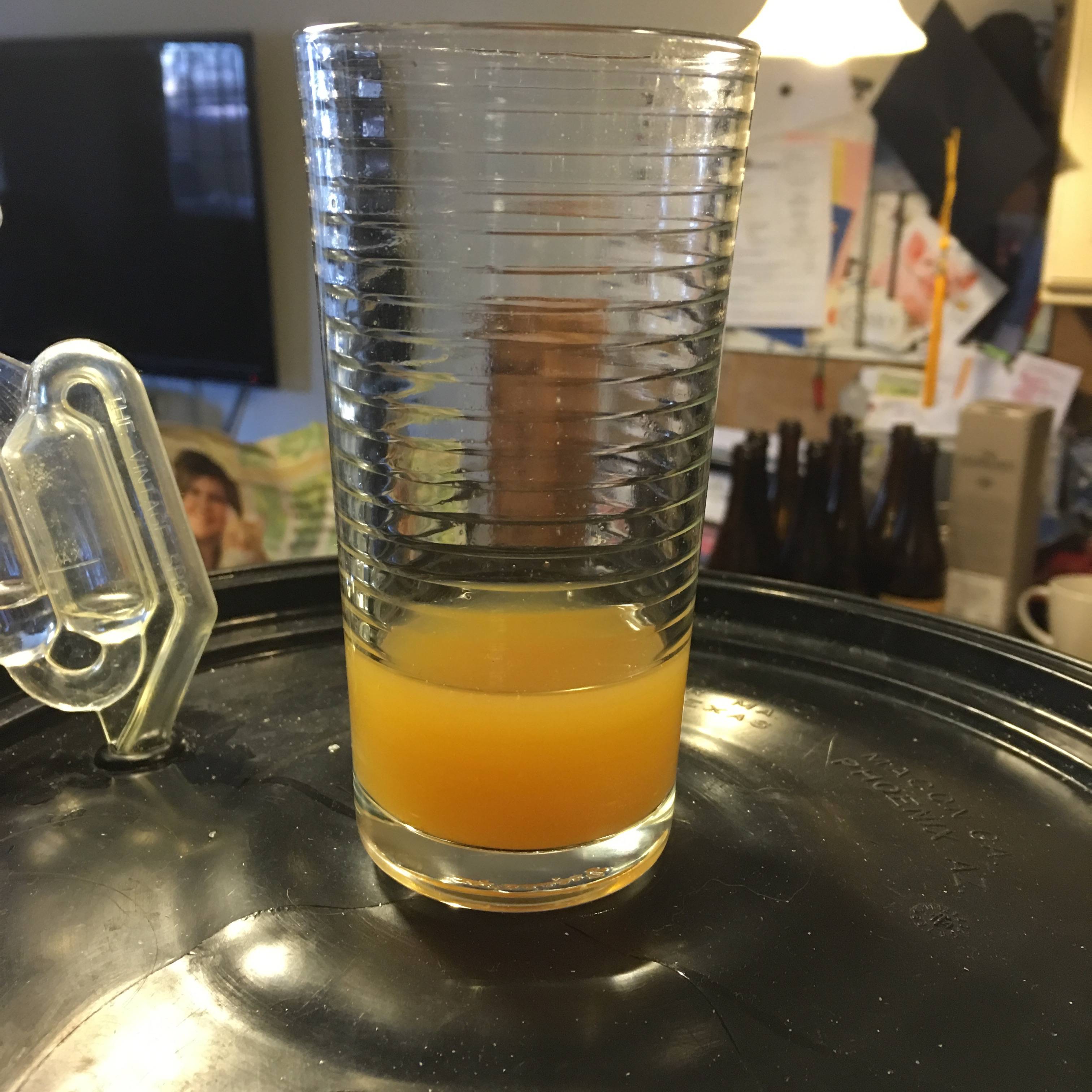
From the tap, and a bit too much carbonation:
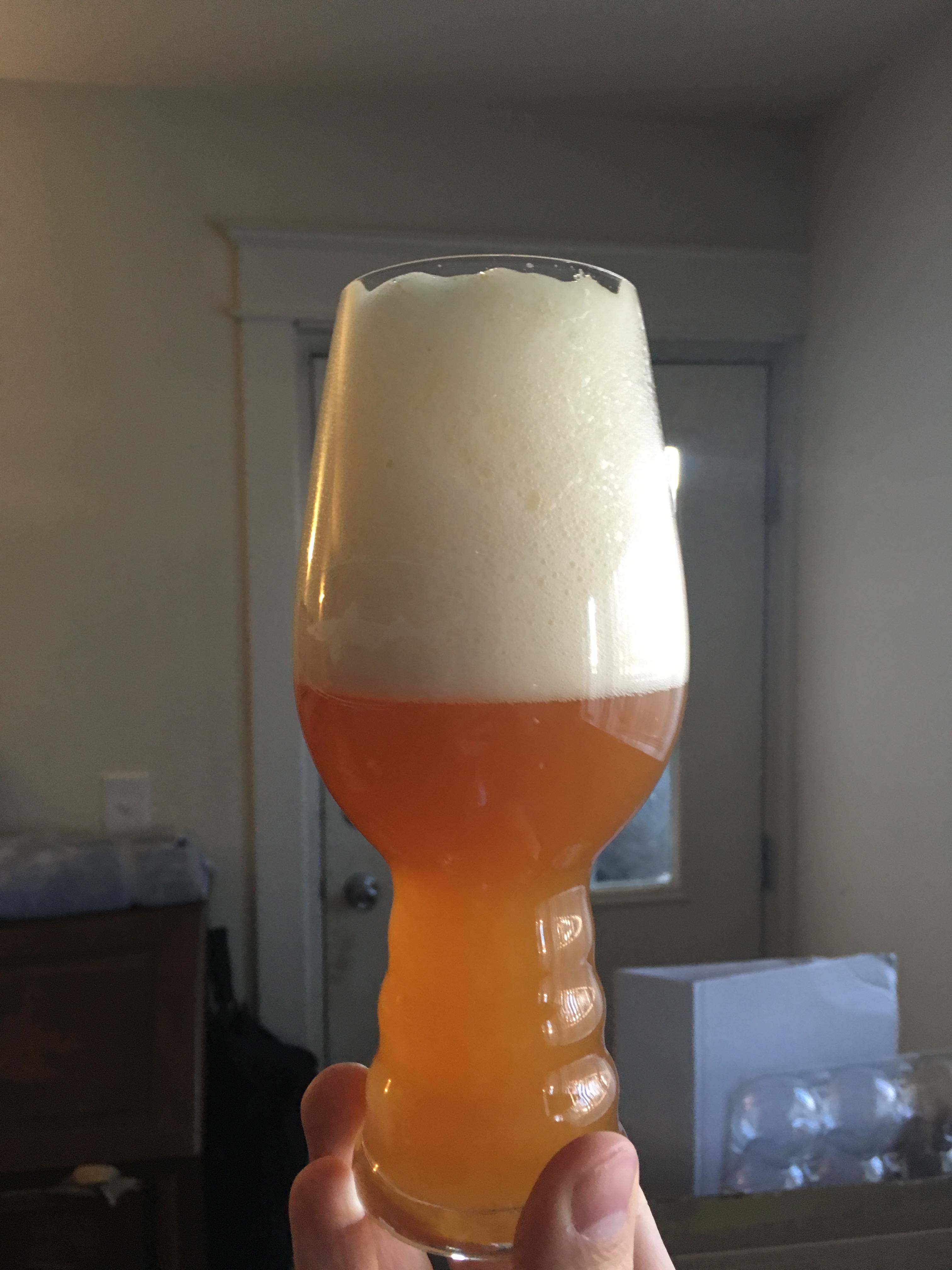
Pretty happy with it, next batch is replaces mosaic with amarillo. Ispeakforthetrees and balesfc have been fans so far.
11lb 2-row
1/2 lb C 60
1 1/2 Red Flaked Wheat
4 oz honey malt
Vermont Ale Yeast (Conan)
I've switched up the hops each batch for fun. Last batch was Simcoe, Cirta, Mosaic
30 min
0.5 Simcoe
Flame out
1.5oz Simceo
2oz Cirta
2oz Mosaic
Dry hop 5-7 days
2oz Cirta
2oz Mosaic
Before kegging:

From the tap, and a bit too much carbonation:

Pretty happy with it, next batch is replaces mosaic with amarillo. Ispeakforthetrees and balesfc have been fans so far.
Ispeakforthetrees
Well-Known Member
Can't believe it's taken me this long to see this thread. Brewed a few batches of NE style IPA, ended up with a happy malt base because the LBSH was out of the wheat I wanted and ended up using red wheat.
11lb 2-row
1/2 lb C 60
1 1/2 Red Flaked Wheat
4 oz honey malt
Vermont Ale Yeast (Conan)
I've switched up the hops each batch for fun. Last batch was Simcoe, Cirta, Mosaic
30 min
0.5 Simcoe
Flame out
1.5oz Simceo
2oz Cirta
2oz Mosaic
Dry hop 5-7 days
2oz Cirta
2oz Mosaic
Before kegging:

From the tap, and a bit too much carbonation:

Pretty happy with it, next batch is replaces mosaic with amarillo. Ispeakforthetrees and balesfc have been fans so far.
I'd crush it tonight bruh
agrippin
Well-Known Member
Keg kicked last weekend. Dry hopping the new batch Sunday.I'd crush it tonight bruh
Snarf1
Well-Known Member
- Joined
- Aug 5, 2013
- Messages
- 7,978
- Reaction score
- 29,425
There is really no reason to make a 'modern' IPA if you can't keg. Even kegging, DO on most homebrew is through the roof.Very cool reading all the tips here. Really need to stop farting around and start kegging.
GetchaPull
Well-Known Member
Bigger DO due to pressure/force carbing or simply due to a singular, large steel vessel?*There is really no reason to make a 'modern' IPA if you can't keg. Even kegging, DO on most homebrew is through the roof.
*Homebrew n00b and I haven't scienced in awhile.
Snarf1
Well-Known Member
- Joined
- Aug 5, 2013
- Messages
- 7,978
- Reaction score
- 29,425
More oxygen bottling than kegging, but both pick up a lot of oxygen with standard homebrew practices.Bigger DO due to pressure/force carbing or simply due to a singular, large steel vessel?*
*Homebrew n00b and I haven't scienced in awhile.
I've attempted a couple.
My first. Decent but on the next attempt, i'm backing off on the bittering charge. Personally 72 IBU is to bitter for this "style", i'm also moving all the 0min charges to whirlpool and doubling up. Same with the DH, doubling that as well. I bottled this one and it defiantly lost a substantial amount of aroma.
75% Golden Promise
12.5% White Wheat
6% Cara-Pils
6% Flaked Oats
London Ale III (Wyeast 1318)
This is my second one, it's really tasty. I'm not sure if i'd change anything, maybe double up on the whirlpool and DH for grins, more towards 3lbs-4lbs/bbl. This isn't my recipe, I found it online from a Hop Hands clone (the grist is at least). It was supposed to be a pale ale at 5.5% abv, but mine ended up around 6.8% abv and 45IBU. Smooth with a hint of bitterness. I think this could stand another 5-10 IBU. (Personally, i'll keep it between 45-50) Kegged, it did lose some of it's aroma but not as much as bottling.
81.8% 2 Row
18.2% Flaked Oats
London Ale III (Wyeast 1318)
My first. Decent but on the next attempt, i'm backing off on the bittering charge. Personally 72 IBU is to bitter for this "style", i'm also moving all the 0min charges to whirlpool and doubling up. Same with the DH, doubling that as well. I bottled this one and it defiantly lost a substantial amount of aroma.
75% Golden Promise
12.5% White Wheat
6% Cara-Pils
6% Flaked Oats
London Ale III (Wyeast 1318)
This is my second one, it's really tasty. I'm not sure if i'd change anything, maybe double up on the whirlpool and DH for grins, more towards 3lbs-4lbs/bbl. This isn't my recipe, I found it online from a Hop Hands clone (the grist is at least). It was supposed to be a pale ale at 5.5% abv, but mine ended up around 6.8% abv and 45IBU. Smooth with a hint of bitterness. I think this could stand another 5-10 IBU. (Personally, i'll keep it between 45-50) Kegged, it did lose some of it's aroma but not as much as bottling.
81.8% 2 Row
18.2% Flaked Oats
London Ale III (Wyeast 1318)
psnydez861
Well-Known Member
Snarf1
Well-Known Member
- Joined
- Aug 5, 2013
- Messages
- 7,978
- Reaction score
- 29,425
Side note on CO2 racking with carboys. **** ain't designed to be pressurized so be careful. I can't remember exactly how, but a friend over pressurized a glass carboy and had it not been in a chest freezer with the door shut, there could have been some serious carnage.
psnydez861
Well-Known Member
Yea. I only co2 rack out of Plastic Carboys.
agrippin
Well-Known Member
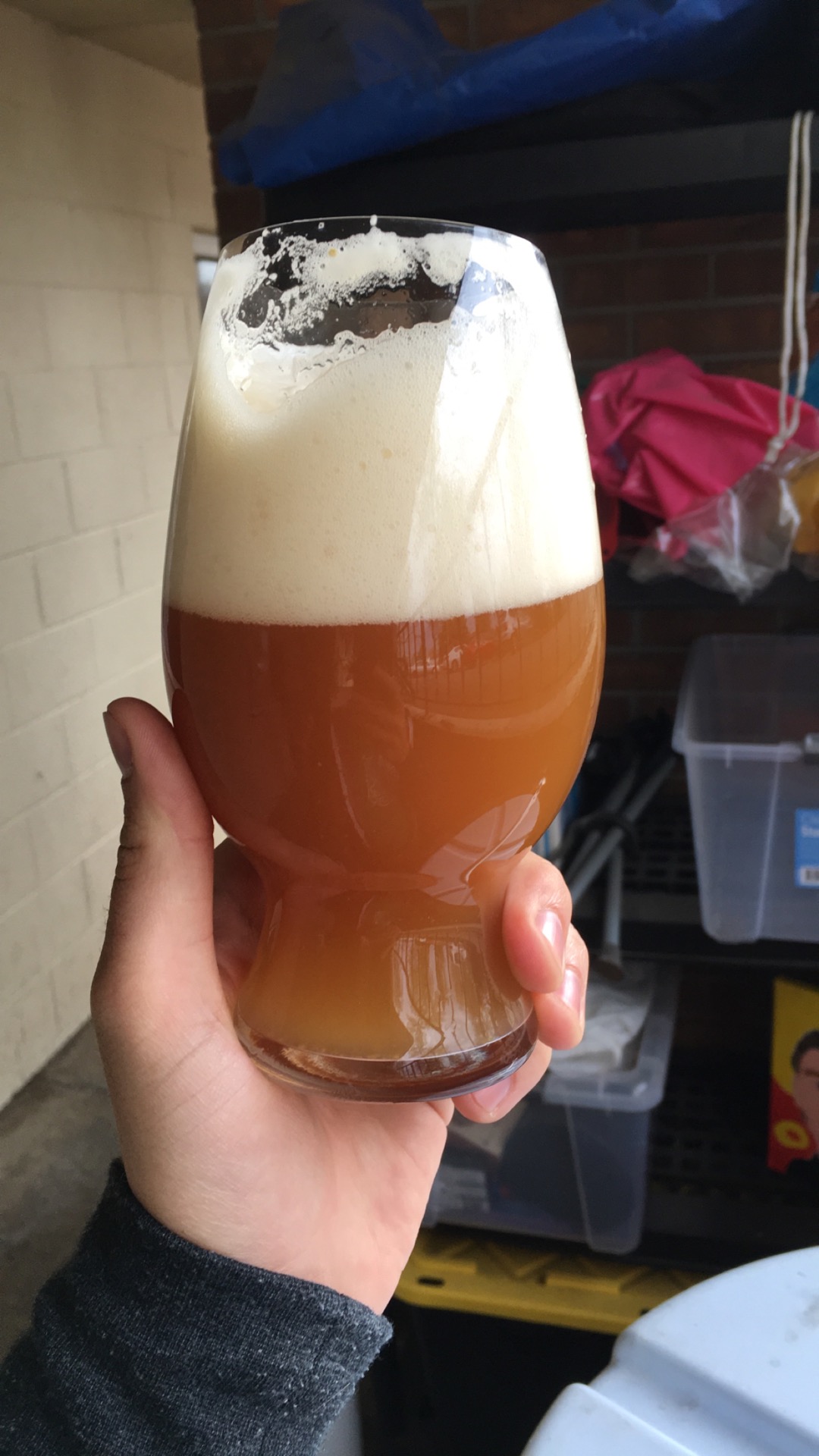
Force carb of batch 3. Honestly forgot what I put in other than simcoe and citra. Probably Amarillo? Color will lighten out once the keg settles. balesfc if you watch GoT, text me. Ispeakforthetrees, same.
ShawDeuce221
Well-Known Member
I think I may have gone a little too Hoof Hearted with this one, it'll be on the gas for the next few days...
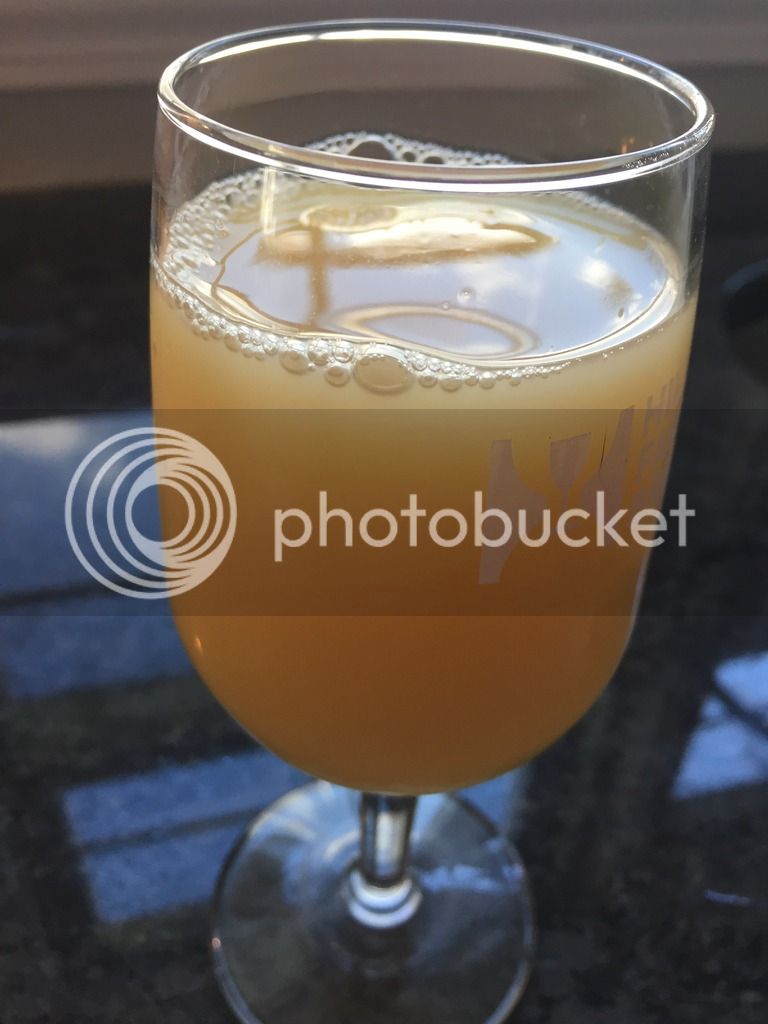
2row, white wheat, flaked wheat, carapils, magnum, galaxy, mosaic, citra, and Y1318

2row, white wheat, flaked wheat, carapils, magnum, galaxy, mosaic, citra, and Y1318
tehzachatak
Well-Known Member
I think I may have gone a little too Hoof Hearted with this one, it'll be on the gas for the next few days...

2row, white wheat, flaked wheat, carapils, magnum, galaxy, mosaic, citra, and Y1318
IMA COME SMASH IT SOON
ShawDeuce221
Well-Known Member
A little premature (story of my life) sample of the NE Pale Ale tastes fuggin great. I'll probably tweak the recipe here and there for clarity's sake but I dig it for my first try.I think I may have gone a little too Hoof Hearted with this one, it'll be on the gas for the next few days...

2row, white wheat, flaked wheat, carapils, magnum, galaxy, mosaic, citra, and Y1318
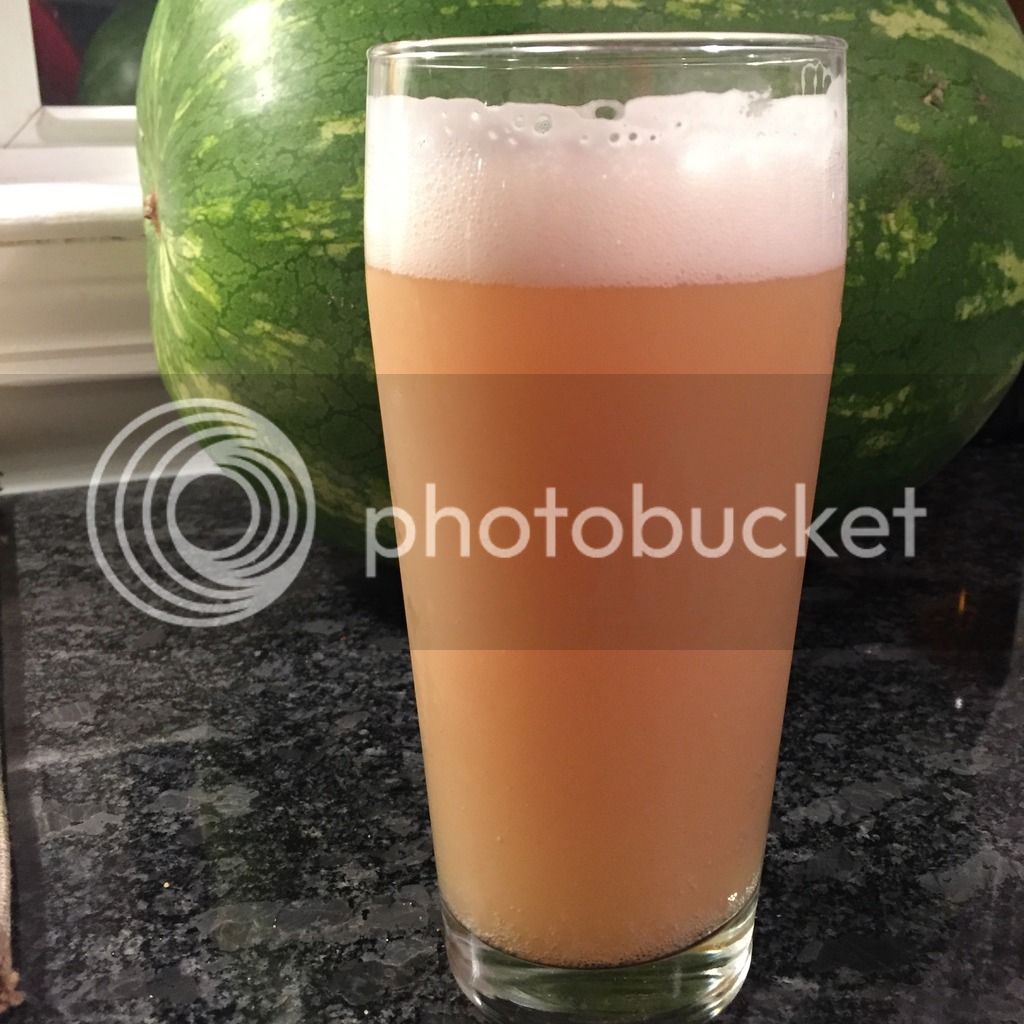
With the assist from HevvyMetalHippie I'll be calling this "Tub Fart" which is sort of an tip of the hat to the Hoof Hearted haziness this guy has
SirDickButts
Well-Known Member
tub fart. LOLOLOLOLOLOL. awesome!
HevvyMetalHippie
Well-Known Member
A little premature (story of my life) sample of the NE Pale Ale tastes fuggin great. I'll probably tweak the recipe here and there for clarity's sake but I dig it for my first try.

With the assist from HevvyMetalHippie I'll be calling this "Tub Fart" which is sort of an tip of the hat to the Hoof Hearted haziness this guy has
When you become famous, you have to take me with you so I can be on your marketing and PR team. +1 for watermelon.
JulianB1
Well-Known Member
I've been periodically giving thought to what I could do to improve mine in the future. One thing that I didn't like about it is that, after the first few days post-kegging where it had a nice vibrant golden color, it took on a noticeable "brownness". Here's a somewhat more recent pic:
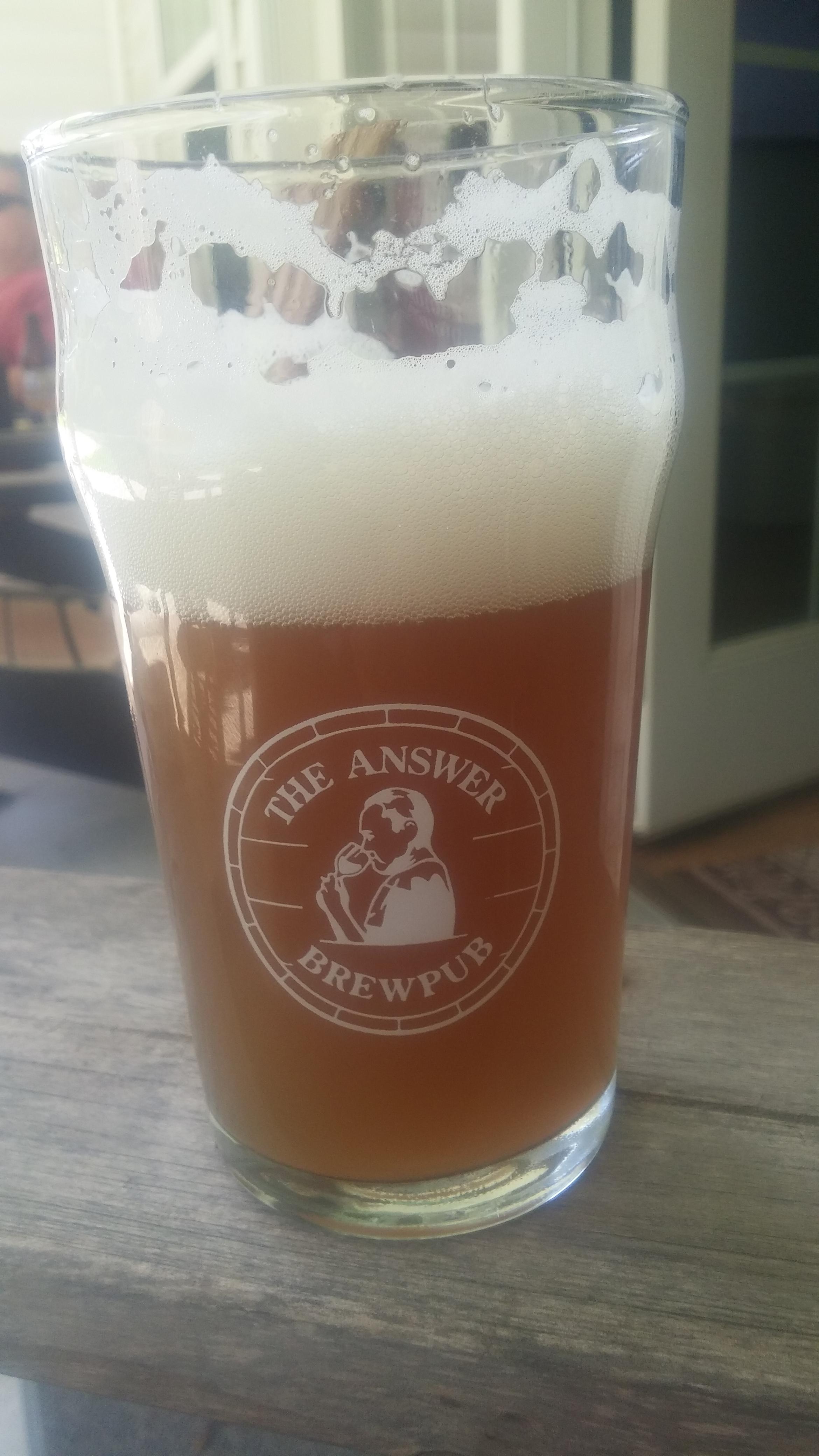
As a point of comparison, the earlier one:
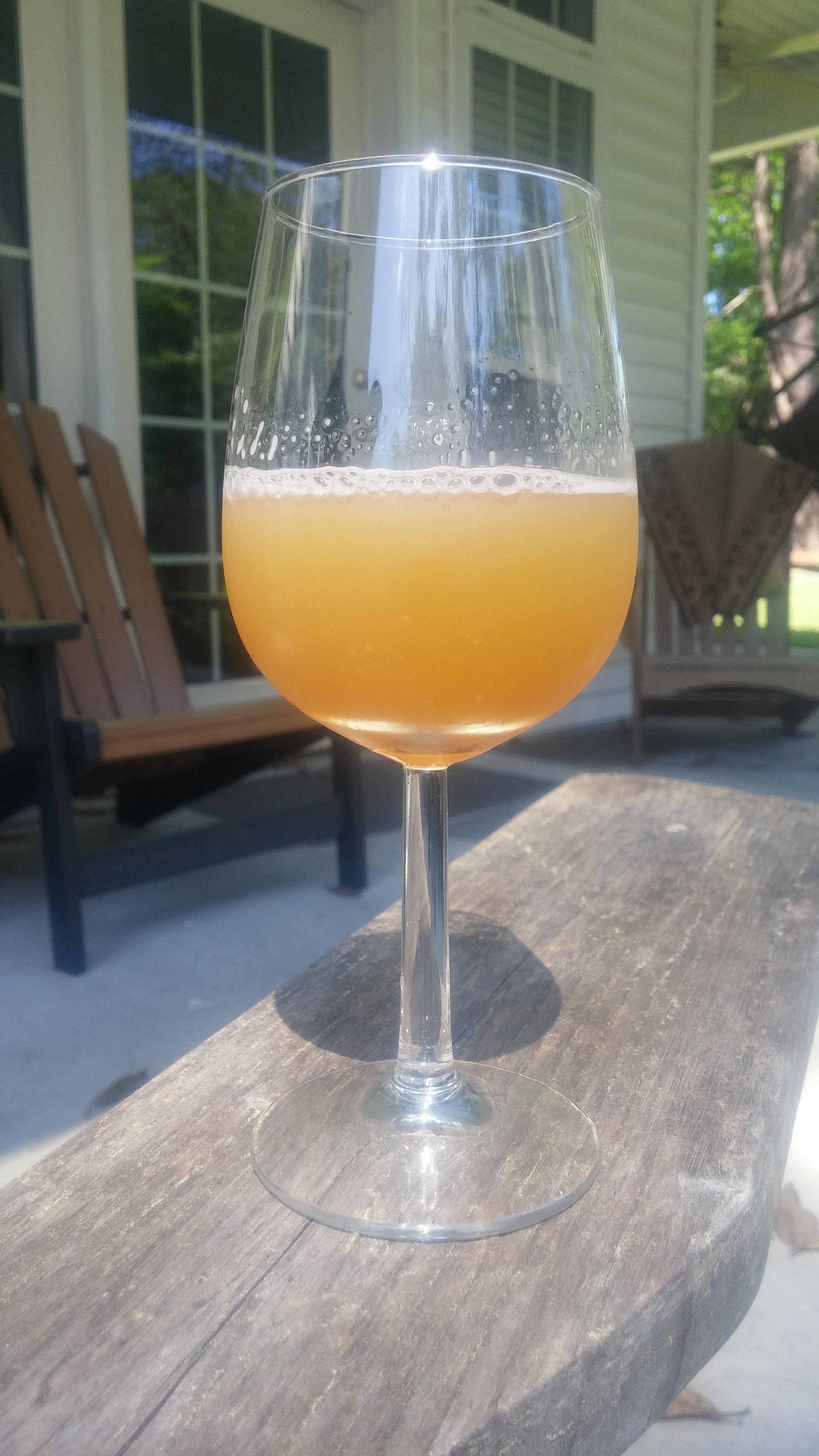
Yeah different glassware, lighting, etc. but this is something that we've all noticed with our own eyes.
One thought I had, and I could be completely out to lunch here, is that I should be putting the hops in a bag (or some other contraption) during the boil and in the dry-hop stages to keep out hop particulate. Is that potentially what's creating that color? I normally just throw my pellets straight into the kettle/fermenter.

As a point of comparison, the earlier one:

Yeah different glassware, lighting, etc. but this is something that we've all noticed with our own eyes.
One thought I had, and I could be completely out to lunch here, is that I should be putting the hops in a bag (or some other contraption) during the boil and in the dry-hop stages to keep out hop particulate. Is that potentially what's creating that color? I normally just throw my pellets straight into the kettle/fermenter.
coldcrash1
Well-Known Member
I've been periodically giving thought to what I could do to improve mine in the future. One thing that I didn't like about it is that, after the first few days post-kegging where it had a nice vibrant golden color, it took on a noticeable "brownness". Here's a somewhat more recent pic:

As a point of comparison, the earlier one:

Yeah different glassware, lighting, etc. but this is something that we've all noticed with our own eyes.
One thought I had, and I could be completely out to lunch here, is that I should be putting the hops in a bag (or some other contraption) during the boil and in the dry-hop stages to keep out hop particulate. Is that potentially what's creating that color? I normally just throw my pellets straight into the kettle/fermenter.
Could be oxidation
Did you transfer under pressure into a purged keg?
JulianB1
Well-Known Member
Could be oxidation
Did you transfer under pressure into a purged keg?
No. Getting the equipment to do this is on my list of upgrades to make to my system.
And you're quite likely correct, or at least that's likely part of the problem.
GuzzleMcBrew
Well-Known Member
I have two 5.6% APA made with a bunch of great hops going into kegs today. Co brewed by blckout20 and my buddy Dan. I am very excited.
^My guess too.Could be oxidation
Did you transfer under pressure into a purged keg?
coldcrash1
Well-Known Member
Not sure how you're handling your dry hop additions, but this may help if you're not doing it already:No. Getting the equipment to do this is on my list of upgrades to make to my system.
And you're quite likely correct, or at least that's likely part of the problem.
Add your hops to empty keg (in paint strainer bag or whatever you use), then purge w co2 before transferring beer from fermenter.
When your dry hop period is over, transfer your beer off the hops into a new purged keg using a jumper as in the pic below. Just a small section of beer line with a liquid out disconnect on each end
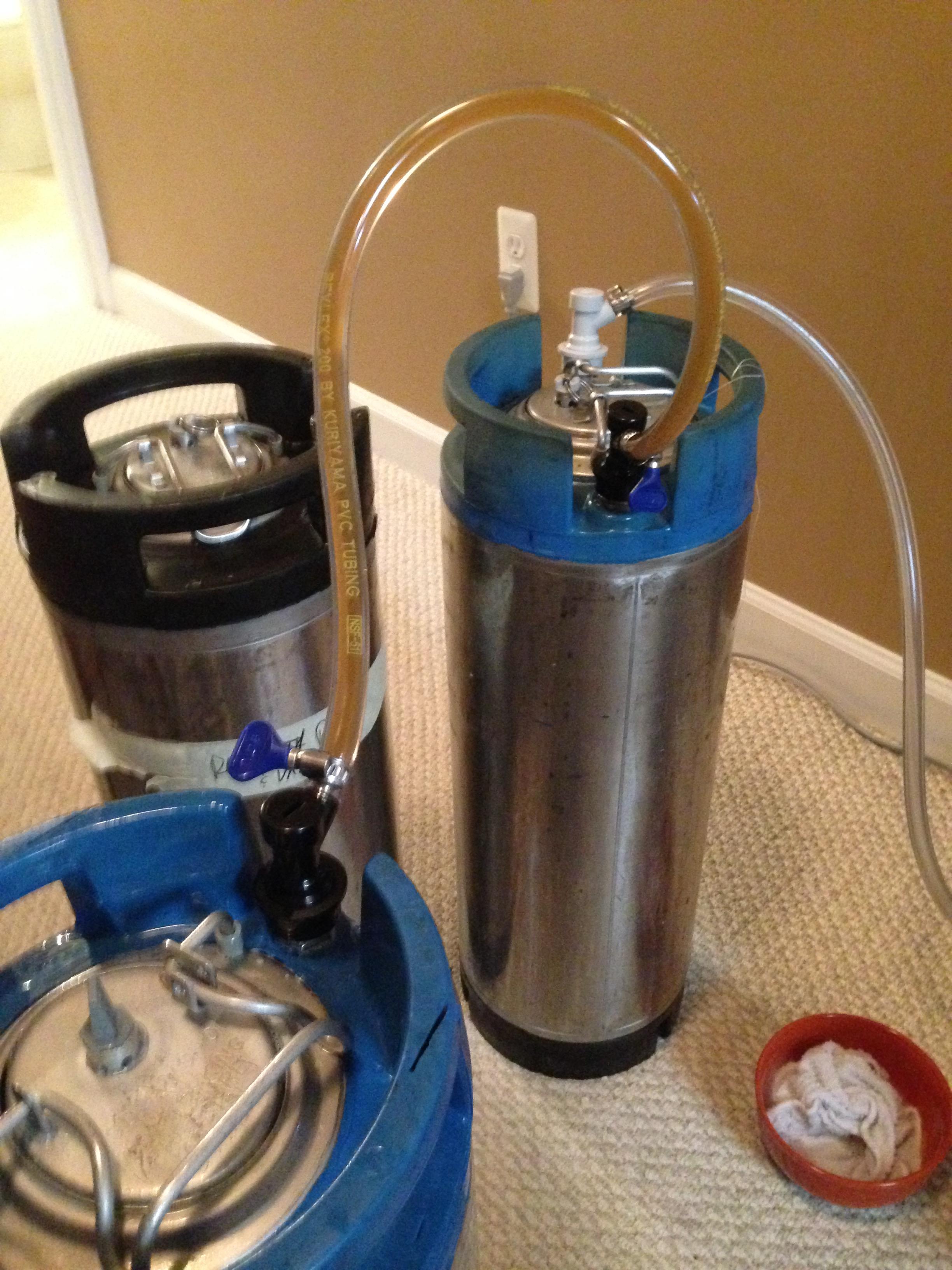
JulianB1
Well-Known Member
Not sure how you're handling your dry hop additions, but this may help if you're not doing it already:
Add your hops to empty keg (in paint strainer bag or whatever you use), then purge w co2 before transferring beer from fermenter.
When your dry hop period is over, transfer your beer off the hops into a new purged keg using a jumper as in the pic below. Just a small section of beer line with a liquid out disconnect on each end

Awesome, thanks for the pic! Was wondering about this. So push CO2 into the keg with the beer/hops, and the beer will be pushed through the out/out connections into the second, empty keg?
coldcrash1
Well-Known Member
Yup. Open the relief valve on keg 2 once you have gas pushing on keg 1.Awesome, thanks for the pic! Was wondering about this. So push CO2 into the keg with the beer/hops, and the beer will be pushed through the out/out connections into the second, empty keg?
andrewdrinks
Well-Known Member
This is another really good long read on New England IPA:
http://cremasbeerodyssey.blogspot.ie/2016/05/a-beautiful-cloudiness.html
http://cremasbeerodyssey.blogspot.ie/2016/05/a-beautiful-cloudiness.html
GuzzleMcBrew
Well-Known Member
The new APA came out great- really similar to Tree House this time around. 7.5 - 8 gallons total beer packaged into the kegs- one on Citra and Nelson, the other on Mosaic and Galaxy. Double batching delicious crusher beers is definitely going to be a thing this summer.
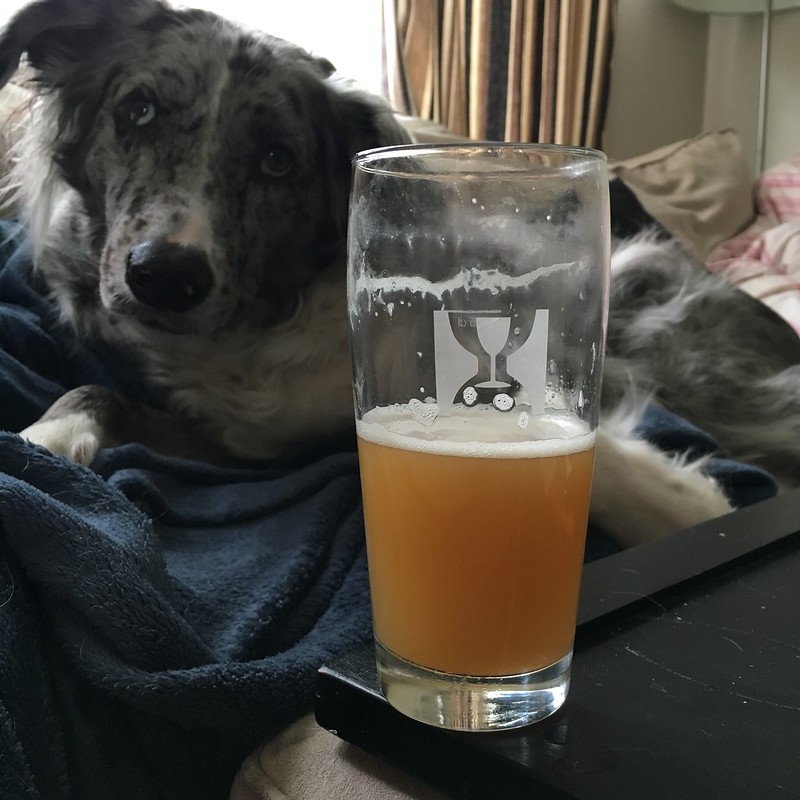

lambandtunaphish
Well-Known Member
ISOThe new APA came out great- really similar to Tree House this time around. 7.5 - 8 gallons total beer packaged into the kegs- one on Citra and Nelson, the other on Mosaic and Galaxy. Double batching delicious crusher beers is definitely going to be a thing this summer.

GuzzleMcBrew
Well-Known Member
I'll make sure it makes it's way to your taste buds, but it will be best served on draft...
GuzzleMcBrew
Well-Known Member
JulianB - did you guys purge the keg? I know you said no to prior questions about racking under pressure, but I am just curious. I always purge my keg but no longer move the beer into the keg under pressure. I have not noticed any particular oxidizing effects in my beers, which typically don't make it outside of a month by just racking them under a co2 bed right through the top of the keg and then burping.
Other questions - did you guys thoroughly burp the keg to rid it of oxygen in the headspace after racking?
Tell me about your kegging process. I have heard anecdotally that using the auto-siphon like I do will allow for a lot of dissolved O2 in a beer even if it is under a CO2 layer, but I haven't noticed any ill effects I would chalk up to Oxidation, per se.
Other questions - did you guys thoroughly burp the keg to rid it of oxygen in the headspace after racking?
Tell me about your kegging process. I have heard anecdotally that using the auto-siphon like I do will allow for a lot of dissolved O2 in a beer even if it is under a CO2 layer, but I haven't noticed any ill effects I would chalk up to Oxidation, per se.
psnydez861
Well-Known Member
I love racking with c02 and have seen a big improvement in my hoppy beer because of it.
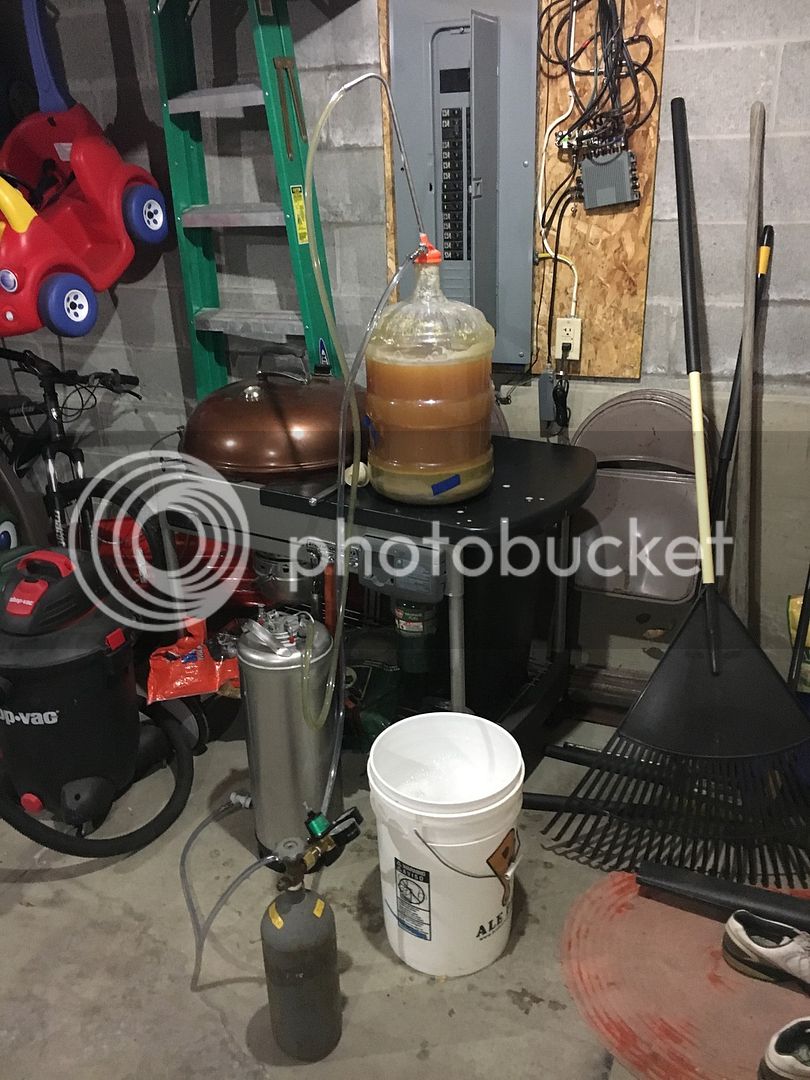
Items needed:
Orange carboy cap
stainless steel racking cane (plastic is an option, but stainless is nice and will last ~forever)
5-7 feet of gas tubing
2- 1/4" nut to 5/16 barb https://www.morebeer.com/products/14-nut-516-barb.html
1- 1/4" male flare to 1/4" barb https://www.morebeer.com/products/flare-fitting-14-male-barb.html
hose clamps to tighten barbs into the gas line and the barb that goes into the one side port of the carboy cap.
Appropriate size tubing for the racking cane(5-8ft), and a ball lock/hose clamp for on the end that will attach to the kegs LO post.
pretty simple process wise.
Sanitize the receiving keg, after keg inside is properly sanitized, hit it with some co2, attach ball lock of racking cane assembly allowing sanitizer to flow from the keg throughout the racking cane into your star san storage bucket. Hit the empty sanitized keg with more Co2 pulling the PRV a few times to purge the keg.
Insert the sanitized racking cane into the beer getting the orange carboy cap to seal on the lid of the carboy (an optional hose camp can be applied here to ensure a tight fit, but can be dangerous if your siphon was to clog...with hops). Pull the PRV again getting all Co2 out of the keg, and leave the PRV open. Apply 2-5psi to your carboy cap, gas goes in, forcing the beer to escape via the stainless steel racking cane to your kegs LO post via the LO ball lock.
Complete transfer, hit with an optional co2 purge to clear the headspace if your a paranoid freak. Keg as normal.
Something I am kinda fooling around with is a 2nd dose of dry hops in a muslin bag in the receiving keg. Dry hop under 20-25lbs of pressure at room temp for 4 or 5 days before putting keg in kegerator. Higher pressure helps to get the essential oils into the beer, rather than into the headspace. Don't do more than 3 oz of hops per muslin bag, and weigh bag down with sterile marbles, or sterile stainless nuts.
Cheers.
Pat
Items needed:
Orange carboy cap
stainless steel racking cane (plastic is an option, but stainless is nice and will last ~forever)
5-7 feet of gas tubing
2- 1/4" nut to 5/16 barb https://www.morebeer.com/products/14-nut-516-barb.html
1- 1/4" male flare to 1/4" barb https://www.morebeer.com/products/flare-fitting-14-male-barb.html
hose clamps to tighten barbs into the gas line and the barb that goes into the one side port of the carboy cap.
Appropriate size tubing for the racking cane(5-8ft), and a ball lock/hose clamp for on the end that will attach to the kegs LO post.
pretty simple process wise.
Sanitize the receiving keg, after keg inside is properly sanitized, hit it with some co2, attach ball lock of racking cane assembly allowing sanitizer to flow from the keg throughout the racking cane into your star san storage bucket. Hit the empty sanitized keg with more Co2 pulling the PRV a few times to purge the keg.
Insert the sanitized racking cane into the beer getting the orange carboy cap to seal on the lid of the carboy (an optional hose camp can be applied here to ensure a tight fit, but can be dangerous if your siphon was to clog...with hops). Pull the PRV again getting all Co2 out of the keg, and leave the PRV open. Apply 2-5psi to your carboy cap, gas goes in, forcing the beer to escape via the stainless steel racking cane to your kegs LO post via the LO ball lock.
Complete transfer, hit with an optional co2 purge to clear the headspace if your a paranoid freak. Keg as normal.
Something I am kinda fooling around with is a 2nd dose of dry hops in a muslin bag in the receiving keg. Dry hop under 20-25lbs of pressure at room temp for 4 or 5 days before putting keg in kegerator. Higher pressure helps to get the essential oils into the beer, rather than into the headspace. Don't do more than 3 oz of hops per muslin bag, and weigh bag down with sterile marbles, or sterile stainless nuts.
Cheers.
Pat
GuzzleMcBrew
Well-Known Member
Nice! Yeah I have wanted to do the full on set up like that for some time but do not yet want to sacrifice fermenting in glass. I don't know why, but glass just seems better to me even though I believe the plastic is inert. I think I will need to go there soon though.I love racking with c02 and have seen a big improvement in my hoppy beer because of it.

Items needed:
Orange carboy cap
stainless steel racking cane (plastic is an option, but stainless is nice and will last ~forever)
5-7 feet of gas tubing
2- 1/4" nut to 5/16 barb https://www.morebeer.com/products/14-nut-516-barb.html
1- 1/4" male flare to 1/4" barb https://www.morebeer.com/products/flare-fitting-14-male-barb.html
hose clamps to tighten barbs into the gas line and the barb that goes into the one side port of the carboy cap.
Appropriate size tubing for the racking cane(5-8ft), and a ball lock/hose clamp for on the end that will attach to the kegs LO post.
pretty simple process wise.
Sanitize the receiving keg, after keg inside is properly sanitized, hit it with some co2, attach ball lock of racking cane assembly allowing sanitizer to flow from the keg throughout the racking cane into your star san storage bucket. Hit the empty sanitized keg with more Co2 pulling the PRV a few times to purge the keg.
Insert the sanitized racking cane into the beer getting the orange carboy cap to seal on the lid of the carboy (an optional hose camp can be applied here to ensure a tight fit, but can be dangerous if your siphon was to clog...with hops). Pull the PRV again getting all Co2 out of the keg, and leave the PRV open. Apply 2-5psi to your carboy cap, gas goes in, forcing the beer to escape via the stainless steel racking cane to your kegs LO post via the LO ball lock.
Complete transfer, hit with an optional co2 purge to clear the headspace if your a paranoid freak. Keg as normal.
Something I am kinda fooling around with is a 2nd dose of dry hops in a muslin bag in the receiving keg. Dry hop under 20-25lbs of pressure at room temp for 4 or 5 days before putting keg in kegerator. Higher pressure helps to get the essential oils into the beer, rather than into the headspace. Don't do more than 3 oz of hops per muslin bag, and weigh bag down with sterile marbles, or sterile stainless nuts.
Cheers.
Pat
I rack into a co2 purged keg and have dry hops in a nylon bag hanging from the inside of the lid. I do a 2 or 3 day dry hop at 20 psi headspace with no gas hookup. Beer takes on some carb and gets a nice dry hop under high (but steadily decreasing) pressure.
psnydez861
Well-Known Member
GuzzleMcBrew
I ferment in plastic and glass. I also co2 rack from glass. It certainly isn't ideal and I'll do my hoppy beers in plastic if I have one open, but now a days I just c02 rack everything. Just gotta be sure to keep your psi low with glass, and be sure your PRV is open, and that the beer isn't gonna clog. But with the low pressures, the psi in the carboy won't go above what you have set on your regulator, and without a hose clamp on your carboy cap, you have a little bit of a safety measure.
I certainly don't advocate co2 racking in glass, as it is very dangerous, but I do it often.
I ferment in plastic and glass. I also co2 rack from glass. It certainly isn't ideal and I'll do my hoppy beers in plastic if I have one open, but now a days I just c02 rack everything. Just gotta be sure to keep your psi low with glass, and be sure your PRV is open, and that the beer isn't gonna clog. But with the low pressures, the psi in the carboy won't go above what you have set on your regulator, and without a hose clamp on your carboy cap, you have a little bit of a safety measure.
I certainly don't advocate co2 racking in glass, as it is very dangerous, but I do it often.
TheMitz
Well-Known Member
JulianB1
Well-Known Member
JulianB - did you guys purge the keg? I know you said no to prior questions about racking under pressure, but I am just curious. I always purge my keg but no longer move the beer into the keg under pressure. I have not noticed any particular oxidizing effects in my beers, which typically don't make it outside of a month by just racking them under a co2 bed right through the top of the keg and then burping.
Other questions - did you guys thoroughly burp the keg to rid it of oxygen in the headspace after racking?
Tell me about your kegging process. I have heard anecdotally that using the auto-siphon like I do will allow for a lot of dissolved O2 in a beer even if it is under a CO2 layer, but I haven't noticed any ill effects I would chalk up to Oxidation, per se.
I don't think so, no (with regards to purging the keg). Which is obviously something I should have been doing, same with "burping" the keg. By this, do you mean opening the PRV with CO2 pumping into the (filled) keg?
I basically just rack using an auto-siphon, but for hoppy beers I'm going to aim for a setup like what psnydez86 has posted. I haven't really noticed any oxidation problems in say, my fruited berliner weisses.
GuzzleMcBrew
Well-Known Member
Awesome- you can get a lot of benefit out of a couple of really small things. two things that pack a big punch process-wise:I don't think so, no (with regards to purging the keg). Which is obviously something I should have been doing, same with "burping" the keg. By this, do you mean opening the PRV with CO2 pumping into the (filled) keg?
I basically just rack using an auto-siphon, but for hoppy beers I'm going to aim for a setup like what psnydez86 has posted. I haven't really noticed any oxidation problems in say, my fruited berliner weisses.
Purge the keg by pumping co2 into it and then releasing pressure and refilling a couple times to ensure co2 is the primary or entire contents. Then when you open the PRV and put in the autosiphon through the lid there will be a co2 layer on top of the beer preventing some o2 interaction. Co2 is heavier than air so some will stay in the keg during a normal racking time.
At the end, burp the keg by pushing in a couple pounds co2, then releasing all headspace pressure with the gas on through the prv. It'll refill, do this again, then push try gas to preferred carbing level. The o2 in the headspace will have been forced out and from here forward only co2 goes in and beer out.
Sure both of these practices waste a little co2, but gas is cheap compared to a whole recipe worth of delicious beer going bad slowly.
Last edited:
GuzzleMcBrew
I certainly don't advocate co2 racking in glass, as it is very dangerous, but I do it often.
This can be made quite a bit safer by wrapping the glass carboy in a heavy blanket or leaving it in a (mostly closed) ferm chamber when you have pressure on the glass.
GuzzleMcBrew
Well-Known Member
I have racked directly to keg from primary with a liquid out connector on the hose of the autosiphon so that the beer goes right to the bottom of the keg under the co2 layer a bunch of times; might as well push the beer out of primary with co2 next time, too. 
GuzzleMcBrew
Well-Known Member
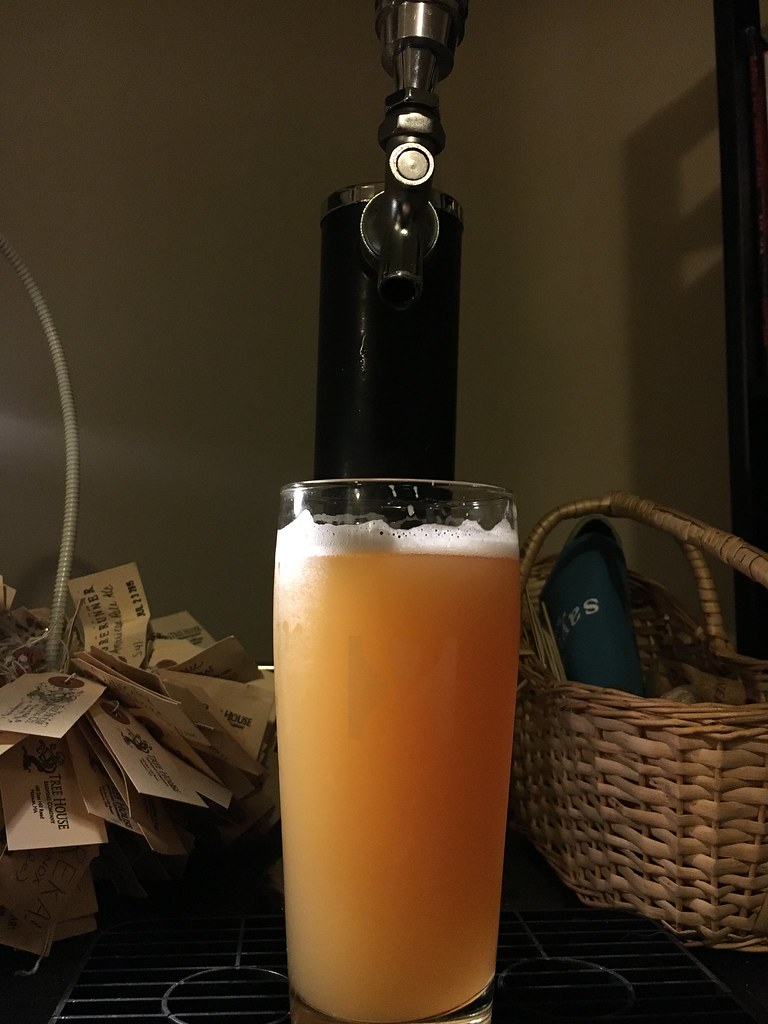
More or less finished product now. It's always really interesting for me observing the flavors changing throughout the carbing and conditioning process for hoppy beer. Some of the swings are pretty wild.
mborden1
Well-Known Member
Ok, I'll join the fun.
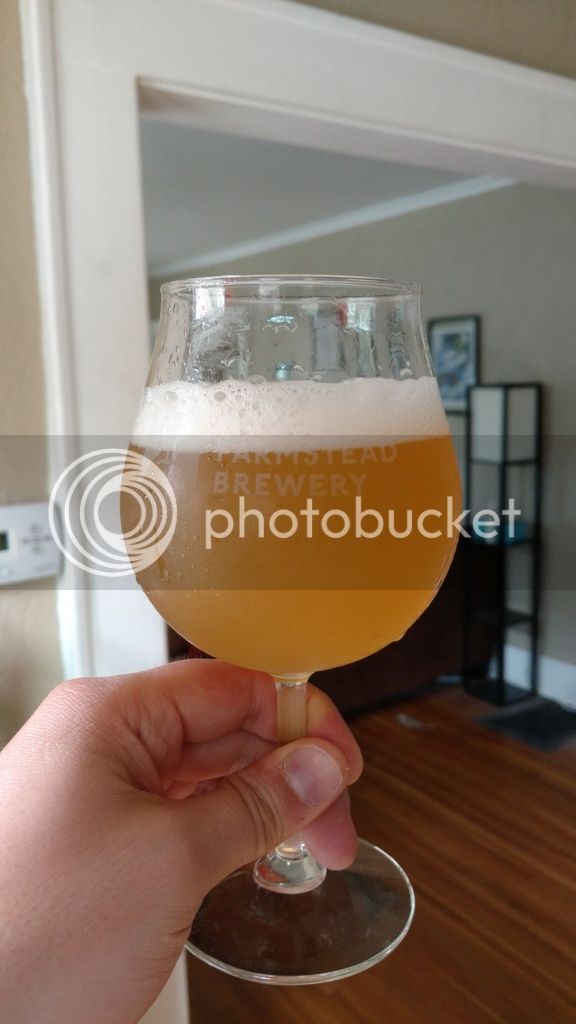
This thread got me to get off my ass and brew a batch of beer for the first time since October 2014. Given my hiatus, I had a few gaffs along the way that were a bit sloppier than my normal brew process. Mash was a few degrees low because I didn't actually measure my grain temp after I left it out on my porch over night. Fermented higher than I should have because I have some Cool Brew bags but I was lazy and used my wife's gel packs instead of the normal frozen water bottles I used to have around. Also had a couple firsts. Played with my water chemistry for the first time. Pushed from my primary into my keg with CO2 for the first time. So lots of variables.
BUT, all that being said, I'm pretty pleased with this one. I had my first draw last night, and I was super unimpressed, but I had already wrecked my palate with a few other IPAs from my fridge. Today, fresh out of work, it's a whole other animal. I look forward to brewing this again to dial it in a bit.

This thread got me to get off my ass and brew a batch of beer for the first time since October 2014. Given my hiatus, I had a few gaffs along the way that were a bit sloppier than my normal brew process. Mash was a few degrees low because I didn't actually measure my grain temp after I left it out on my porch over night. Fermented higher than I should have because I have some Cool Brew bags but I was lazy and used my wife's gel packs instead of the normal frozen water bottles I used to have around. Also had a couple firsts. Played with my water chemistry for the first time. Pushed from my primary into my keg with CO2 for the first time. So lots of variables.
BUT, all that being said, I'm pretty pleased with this one. I had my first draw last night, and I was super unimpressed, but I had already wrecked my palate with a few other IPAs from my fridge. Today, fresh out of work, it's a whole other animal. I look forward to brewing this again to dial it in a bit.
Similar threads
- Replies
- 3
- Views
- 621

